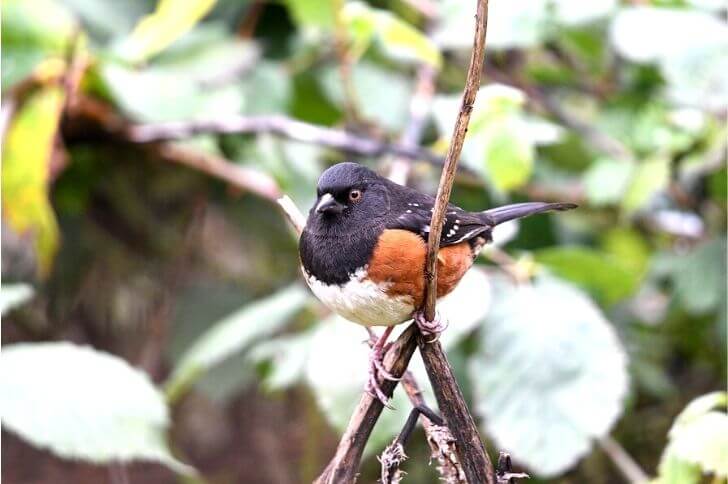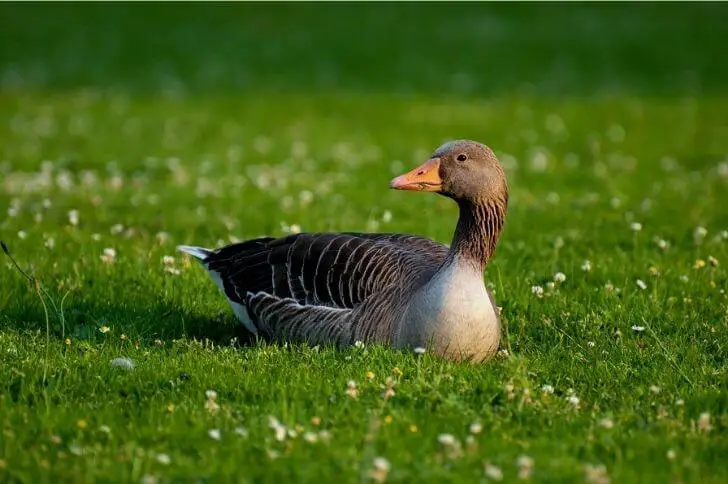The State of Ohio is home to hundreds of bird species, about 440 of them. And, these birds come in a variety of colors; both vibrant and subtle.
Below we’ll look at black and white birds in Ohio that either visit bird feeders or that you can spot in the wild when you go bird watching.
So, whether you want to learn about a bird you saw in your yard or want to add a name to your birding journal, this list is perfect for you.
1. Red bellied Woodpecker
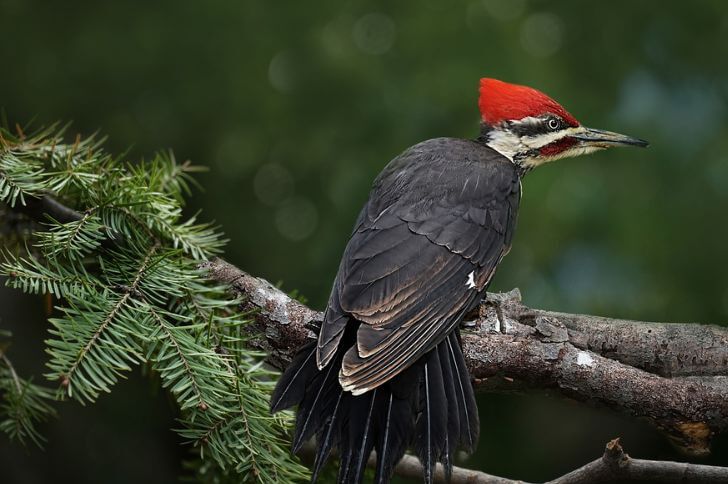
With a black and white barred back, the red bellied woodpecker is one of the most beautiful birds of Ohio. These birds prefer to live in deciduous forests, but can also be found in mixed woods and open areas.
Identification:
Like other birds in their family, red-bellied woodpeckers are easy to spot. Both sexes are about 9.5 inches in length. The male has a heavily barred back with a bright red nape and crown.
Their belly is white with a black and white undertail. Females are similar but are duller. Also, they do not have a crown. Red-bellied woodpeckers have black thick bills that come in handy during breeding season.
Other facts:
Speaking of breeding season, these black and white birds in Ohio are monogamous and typically mate for life. The female builds a nest in a tree cavity and incubates the eggs until they hatch. The chicks stay with the parents for about six weeks after hatching.
They eat insects, nuts, berries, and seeds. These red bellied woodpeckers are considered to be common birds, meaning their numbers are stable.
2. Black-Capped Chickadee
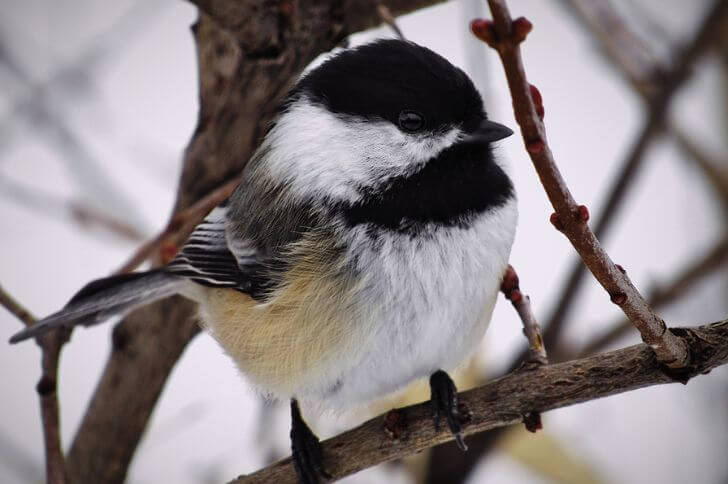
The Poecile atricapillus or the black capped chickadee is a small non-migratory songbird that is common and conspicuous in Ohio. These birds are known for their intelligence and playful behavior.
Identification:
Adults share habits as well as plumage. They spot a black cap and throat, beautiful white cheeks, gray back with black wings and whitish underneath.
On average, the adult is 4.7-5.9 inches with a wingspan of 6-8.3 inches. They are slightly smaller than house sparrows.
Other facts:
How can I attract black-capped chickadees to my yard? These passerine birds favor suet feeders and also enjoy peanuts and sunflower seeds. Also, consider getting a birdhouse that is large enough for a mating pair.
They are also popular for their beautiful markings and melodic song. Black capped chickadees typically live in deciduous or mixed forests, but can also be found in urban areas.
3. Downy Woodpecker
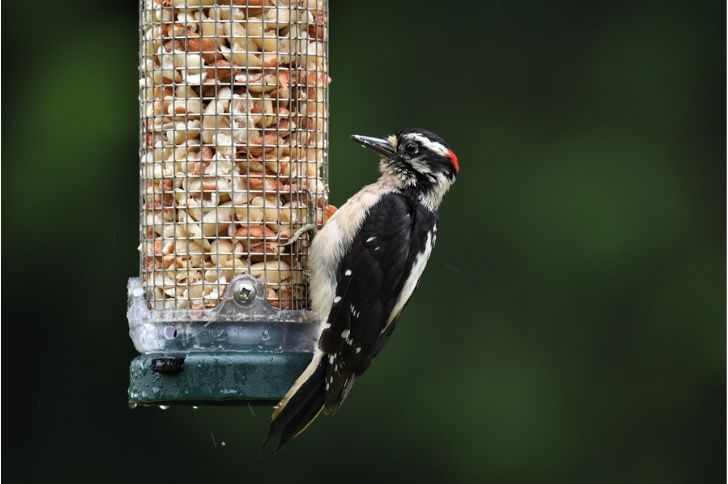
Known for its constant drumming sounds, the downy woodpecker is a small woodpecker that is widespread in Ohio.
Identification:
Downy woodpeckers are between 5 and 6.5 inches long, with a wingspan of about 10 inches. They weigh between 0.7 and 1 ounce. In comparison, their cousin, the pileated woodpecker, is about 20 inches in size with a wingspan of up to 30 inches.
Downy woodpeckers have black and white feathers, a striped black and white head with a small red spot, and a white stripe down the center of their back. They have a short, stout bill and strong legs.
Other facts:
When nesting, the female lays up to 8 white eggs in a nest hole. They take about three weeks to hatch, revealing naked and clumsy baby woodpeckers.
Downy woodpeckers use their bills to drill into tree bark to find insects to eat. They also store food in crevices in bark for later consumption. Downy woodpeckers can be seen year-round in many parts of Ohio.
4. White-Breasted Nuthatch

Favoring woodland edges and mature woods, the white-breasted nuthatches are another type of small black and white birds in Ohio.
Identification:
This small bird is easily recognizable by its blue-gray back, black cap, and white underparts. Females do not have the black cap. Both sexes spot a white face and a rusty patch in their undertail.
These birds are about 5.5 inches in length with a wingspan of up to 10 inches. Notice their long, narrow bill and short tail.
Interesting facts:
The white breasted nuthatch is a busy little bird that can often be seen foraging for food on tree trunks and branches.
These birds are known for their ability to twist their heads upside down to look for food hidden in crevices. White breasted nuthatches are also known for their loud, nasal call, which can be heard throughout the forest.
They are also known to visit suet and sunflower feeders. These small birds can live up to 9 years.
5. Black and White Warbler
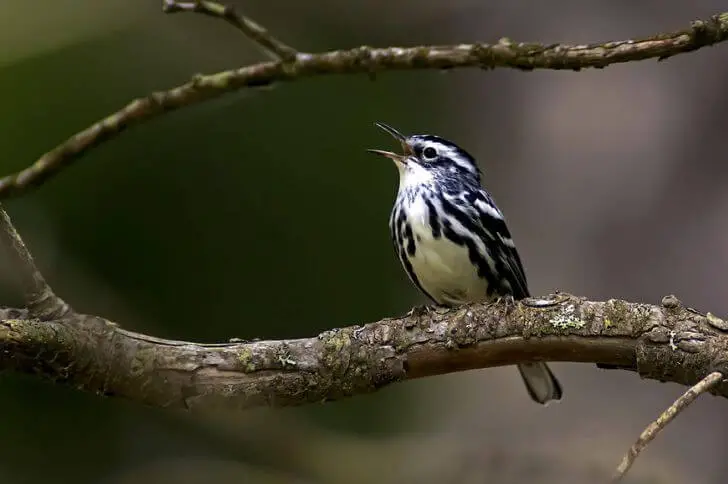
Another group of backyard birds in Ohio you should be on the lookout for are the black and white warblers. A member of the parulidae family, this songbird prefers mixed forests and deciduous forest. Also, they are a migratory bird species.
Identification:
When you first come across this black and white bird, you’ll notice its head appears flat, this is because of its short neck. The bird has bold black and white stripes.
You can tell the sexes apart by looking around their ears; male spot a large black patch while females don’t have one.
Interesting facts:
The black and white warbler is a small songbird that can be found in eastern North America. They are usually seen in pairs or small flocks and are most active during the morning and evening.
These birds are very vocal and can be heard singing throughout the day. They feed on insects, which they catch while flying or glean from tree branches. Black and white warblers build their nests near the ground, often in a clump of grass or shrubs.
The song of this warbler is a series of “weesy” notes repeated for about three seconds. Their calls are sharp “pit” or “chip” sounds.
6. American Black Duck
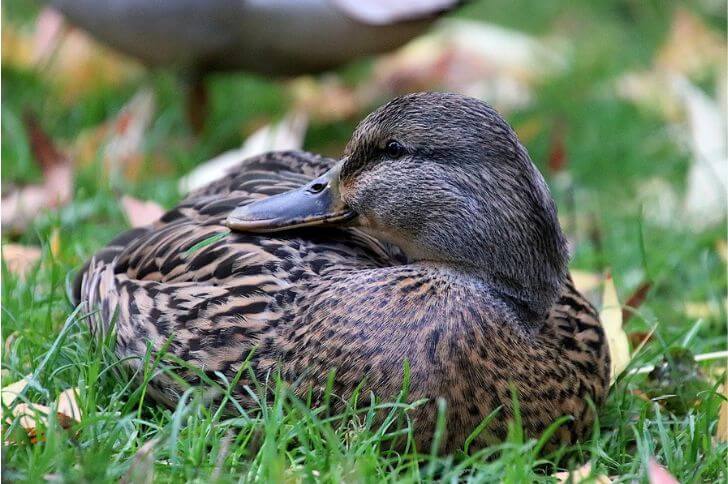
I know you might be puzzled after looking at the image above. Yes, the American black duck also falls into the category of black and white birds in Ohio. Hear me out.
Identification:
The American Black Duck is a large dabbling duck that can be found in wetlands of Ohio. They are similar in appearance to the Mallard, but they are slightly smaller with a shorter neck and bill.
It’s between 21 and 23 inches long. Both sexes have dark brown to black feathers and white underwings. This means you can only see the white plumage when the duck is in flight. How can you tell the sexes apart?
The male has a pale brown head with a noticeable yellow bill while the female has a dull olive bill.
Interesting facts:
American Black Ducks eat a variety of things, including aquatic plants, insects, and small fish. They are generally shy ducks, but can be quite aggressive during the breeding season.
Each season they’ll lay 6-14 eggs that can take up to 33 days to hatch.
Related Read: Comprehensive list of black birds with white chests
7. Yellow-Throated Warbler
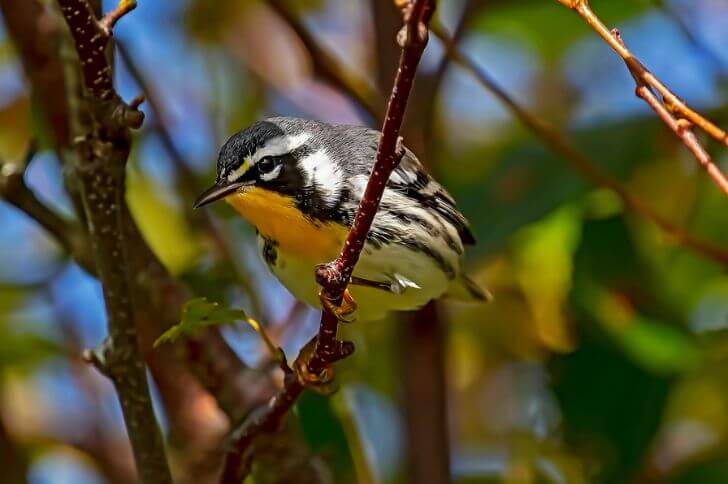
Is the yellow-throated warbler rare? No, there are thousands of members of this species across Ohio.
Identification:
They are closely related to the black and white warblers. This means they have similar plumage and are the same size. They have a bright yellow throat and chest. The rest of their body is black and white stripes on the upperparts and white below.
Interesting facts:
The yellow throated warbler is a small songbird that can be found in North America. These birds are usually seen in trees or bushes, and they often sing to let others know of their presence. Yellow throated warblers eat insects, spiders, and other invertebrates.
They are also known for their sharp “chip” sounds. They also lay greenish eggs with speckles.
8. Ring-necked Duck
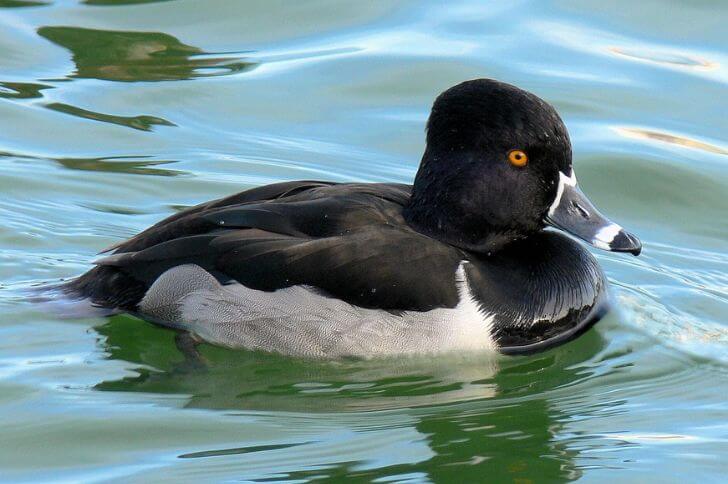
Another black and white duck of Ohio is the ring-necked duck. Often found in small flocks, you can find them around water bodies.
Identification:
How can I identify the ring-necked duck? Males feature a glossy black head, gray sides and a white chest. Notice their black-tipped gray bill and stunning yellow eyes. In contrast the female of this duck species has a dark brown head and grayish heads. Their eyes are brown.
Other facts:
The ring-necked duck is a small diving duck that breeds in freshwater marshes. During the breeding season they’ll lay 6-14 0.8-inch eggs that take about 25-29 days to hatch.
And, unlike other bird babies, the ring-duck babies are able to leave the nest after two days. They eat aquatic insects and plants.
9. Bobolink
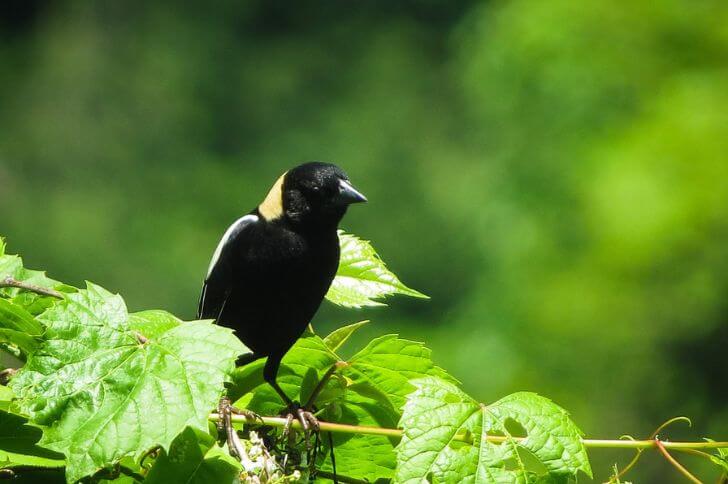
Is bobolink endangered? Yes, unfortunately in countries such as Canada, this bird is at risk due to habitat loss. Is bobolink a songbird?
Identification:
The bobolink is a small North American bird that is known for its beautiful song. It is a songbird that is part of the new world blackbird family.
Sexes are very different, making it easy to tell them apart. The male is mostly black with a yellow nape and white patches on the wings and back. The bill is a short black-gray beak. Females are a heavily streaked brown above and cream below. Their bill is pinkish.
Interesting facts:
These birds can be found in grasslands and meadows, and they are most active during the spring and summer. Their main meals consist of insects and seeds, and they can be seen perched on telephone wires or fences.
Bobolinks are also known for their reproductive habits; the males build nests out of grasses, and the females lay eggs in the nests. After hatching, the parents care for the babies.
10. Great Black-backed Gull
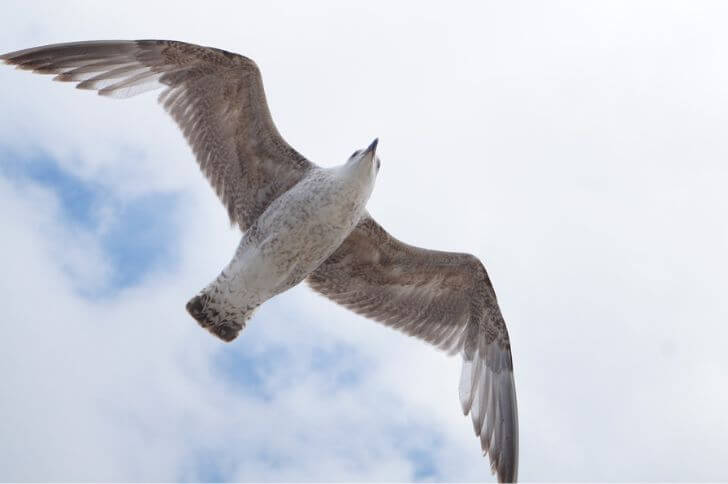
The great black-backed gull or the Larus marinus is one of the largest members of the gull family. It is a large, dark seabird with a heavy bill.
Identification:
The adult has a white head and neck, black wings and back, and white below. Notice their pink legs and yellow bill. Also, their eyes are yellow with a reddish skin around them. The juvenile is mottled brown with dark streaks on the upper body and white below.
Other facts:
The great black-backed gull breeds along the coast or lakes. It nests on the ground, often in colonies. The eggs are grayish or grayish white, and the chicks are covered in downy feathers.
The great black-backed gull feeds mainly on fish, but it also eats other marine animals, including crabs and mussels. It can be seen near seacoasts and large lakes.
11. Black-Necked Stilt

Abundant in shorelines and coastlines, the black necked stilt is a long-legged wader that amazes us with its graceful walk.
Identification:
Adults have long, bright red legs and a long, thin black bill. They are white below with some black on the wings and back. The male is black-necked stilt is larger than the female’s.
Adults spot white feathers above and are white below. The young are similar to the adults but have shorter legs and a dollar bill.
Other facts:
These birds feed on insects, crustaceans, and other small aquatic creatures. They often forage by probing in mud or shallow water with their bill.
Their calls are sharp “keek” and “yap” sounds. During breeding season, this black and white bird of Ohio will lay 2-5 olive eggs that take about a month to hatch. Chicks have feathers and are clumsy during the first day of their lives.
12. Canada Goose

Large and loud, the Canadian goose or Canada goose is a migratory bird that favors any large bodies of water, ponds, park laws and even yards.
Other facts:
These birds are known for their distinctive black and white markings, as well as their tendency to form large flocks. Canada geese can be found in many different habitats, including wetlands, meadows, and urban areas.
These birds are omnivorous. They typically feed on grasses, insects, and small fish. In the winter months, Canada geese will often eat grain from farmers’ fields.
Canada geese are monogamous birds, meaning that they mate for life. The male and female work together to build a nest out of grasses and other materials, and then lay between two and six eggs. Both parents care for them until they are able to fly.
13. Hairy Woodpecker
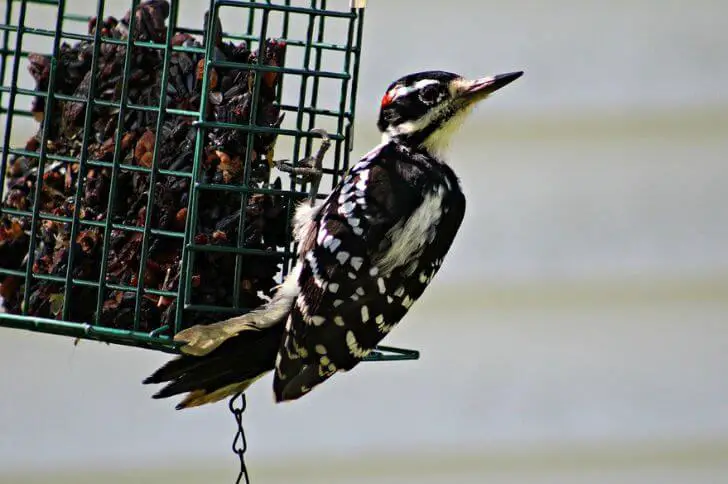
Another member of the loud woodpecker family that you can spot in your yard is the Hairy woodpecker. Why is it called a hairy woodpecker?
Identification:
It is a medium-sized bird that is easily identified by its black and white plumage, and the long hair-like feathers that extend down the back of its head.
These long feathers are what gives the hairy woodpecker its name. Also, the male has a red spot at the back of his head. Females do not.
Other facts:
How can you attract a hairy woodpecker to your backyard? These birds are known to be good at drilling holes on dead wood. So, if you have a few dead trees, you can leave them in an upright position in your yard.
A pair may spot it and turn it into a home. Also, these birds are known to visit peanut bird feeders.
Hairy woodpeckers are known for their loud, hammering call, which can be heard from some distance away. They are also one of the few woodpecker species that frequently nests in trees near the ground.
14. Eastern towhee
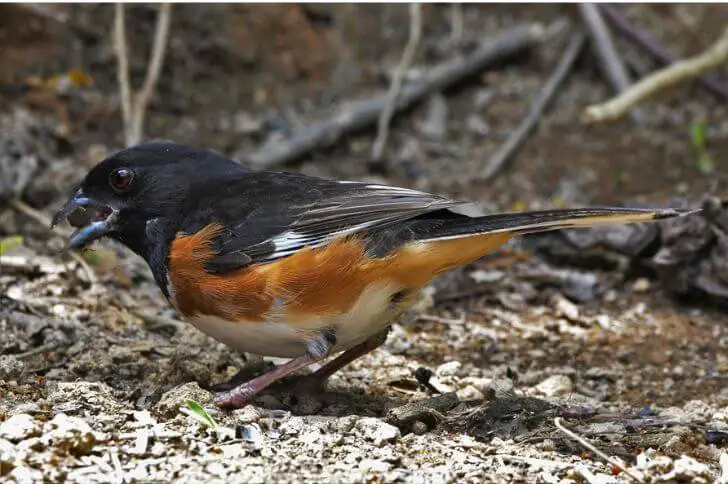
Eastern towhees are a passerine bird in the sparrow family. They are usually considered a bird of woodland edges, but it also inhabits scrublands, meadows, and gardens.
Identification:
This species is 6.8- 8.2 inches long and weighs 1.1 – 1.8 oz. The breeding male has a black head with red eyes, white belly and rufous sides. Their wings also have white patches. The female is mostly brown in their upperparts with some streaks on the wings. They also have white bellies.
Other facts:
What are the sounds of the eastern towhee? Their calls are a series of “chewink” sounds while their songs are loud songs which sound like “drink-your-tea” repeated for at least three seconds.
These songs come in handy during nesting season where male use them repeatedly to mark their territory. After building the cup-shaped nest, females lay up to 6 pinkish or grayish eggs that are incubated for 2 weeks.
15. Carolina Chickadee

Carolina chickadee is a 5-inch bird in the tit family. It is a resident breeder throughout the eastern United States and much of Canada.
Identification:
These birds are black and white, with a black cap and bib. The Carolina chickadee is smaller than the common black-capped chickadee, but larger than the boreal chickadee.
There is some overlap in range between these three species, but usually each species can be told apart easily by size and coloration. Note its grayish-black wings.
Other facts:
The Carolina chickadee feeds on insects, spiders, seeds, and fruit. It forages in trees and shrubs, often hanging upside down to glean food from branches and leaves. This bird nests in a cavity such as a tree hole or abandoned woodpecker nest.
16. Rose-breasted Grosbeak
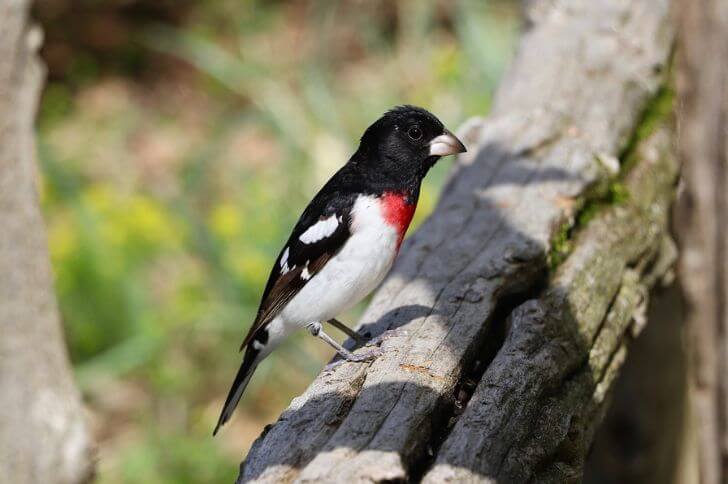
We recently looked at red chested birds and the Rose-breasted grosbeak made it onto that list because of its unique plumage. We’ve also included it on this list because of its coloring and also because there are thousands of birds from this species in Ohio.
Identification:
The rose-breasted grosbeak is a beautiful bird that is easy to spot in Ohio. The male of the species has a black head and back, with a white belly and red chest.
Notice the pinkish bill. The female is a heavily streaked brown with beautiful white eyebrows. They also have a pale bill. Both sexes have a wingspan of about 13 inches.
Interesting facts:
The rose-breasted grosbeak is a songbird, and its song has been described as being like that of a robin. The bird feeds on insects, berries, and seeds. It nests in trees, and usually lays 3-5 eggs per clutch. The rose-breasted grosbeak is not considered to be endangered or threatened.
17. Common Eider
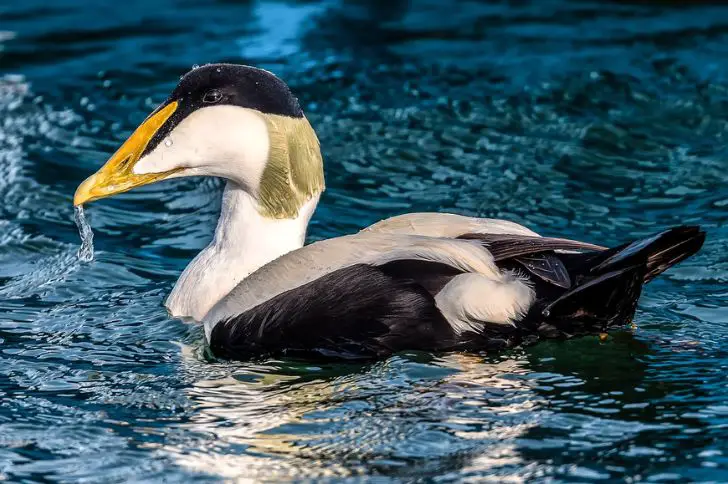
Found in the colder waters of the northern hemisphere, the common eider is a seaduck that is easily recognizable by its large size and bulky build. How long does the common eider live?
Identification:
Up to 22 years. The male common eider has black and white plumage, with a greenish neck and black cap. The female is much less brightly colored, with a brownish-red body and black barring. Both sexes have grayish bills.
Interesting facts:
The common eider feeds on mollusks, crustaceans, and marine worms. They often form large flocks while feeding, using their strong bills to break open shells. Common eiders breed in areas with coastal cliffs or tundra near the sea.
Their nests are lined with down plucked from the females’ breast feathers, which keeps the eggs warm even in the coldest weather.
18. Snow bunting
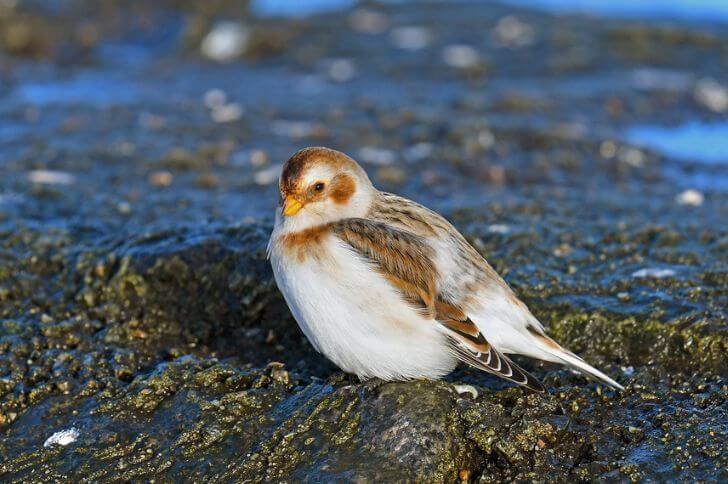
The snow bunting is a beautiful bird that is well-adapted to life in the coldest regions of Ohio.
Identification:
These birds are mostly white, with black and brown markings on their wings and backs. Females have a streaked back and pale below. These birds are about 5.9 inches, making them slightly smaller than blue jays. They have short black bills.
Other facts:
The snow bunting is a member of the calcariidae family, and like other birds in this family, they are good at flying and catching insects.
Snow buntings are monogamous birds, meaning that they mate for life. The female lays four to six eggs in a nest made of grasses, feathers, moss, and lichens.
19. Tufted Duck

Tufted ducks are a species of waterfowl that is a resident in parts of Ohio. The tufted duck gets its name from the distinctive tuft of feathers on its head.
Identification:
The tufted duck is a relatively small waterfowl, measuring just 16 inches in length. The tufted duck is mostly black in color, with a white breast and belly. Females are dark brown. Check out their eyes, a striking yellow color.
Other facts:
The tufted duck is an expert swimmer and diver, and can stay underwater for up to two minutes at a time. The diet of the tufted duck consists primarily of aquatic plants and invertebrates. The tufted duck nests near bodies of water, and typically lays between 6 and 10 eggs at a time.
20. Dark-Eyed Junco
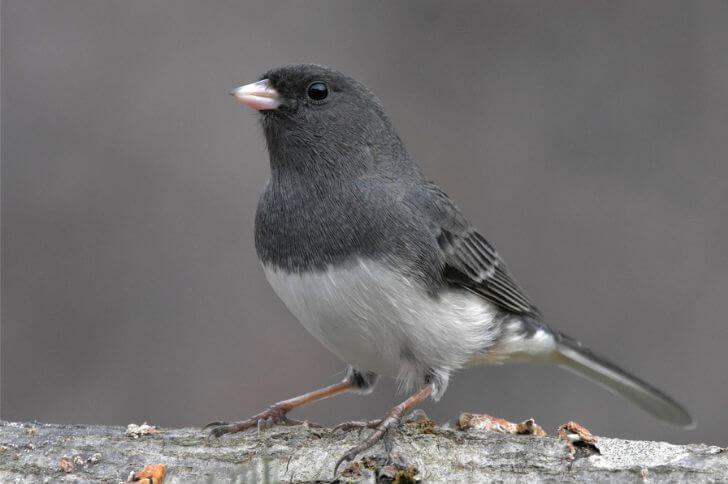
Dark-eyed juncos are small sparrows that are very common across North America. Can you attract them to your yard? Yes, they are known to often visit bird feeders as well as bird baths.
Identification:
These birds are dark gray-black on their heads, back, chest, and tail and white below. They also have a short pink bill.
Other facts:
The bird is a common sight in wooded areas and gardens. The dark-eyed junco is not considered to be endangered. However, the bird’s population has declined in recent years due to habitat loss and other factors.
Final Thoughts on Black and White Birds in Ohio
There are numerous black and white birds of Ohio. From the dark-eyed junco to woodpeckers, different bird families have made Ohio their home. In the article below you can get numerous names to add to your birding journal and how to attract them to your yard.
Source:
https://www.dnr.sc.gov/wildlife/species/waterfowl/divingducks/commoneider.html
https://en.wikipedia.org/wiki/Bobolink
Hi, my name is Steve. My friend and I started the spanishbirdguides.com to share our passion with other like-minded people. So, if bird watching is your thing, you’ll love this blog. I’ll share what I’ve learnt about both local birds and those found in other parts of the world. Also, I’d love to hear your experiences.
